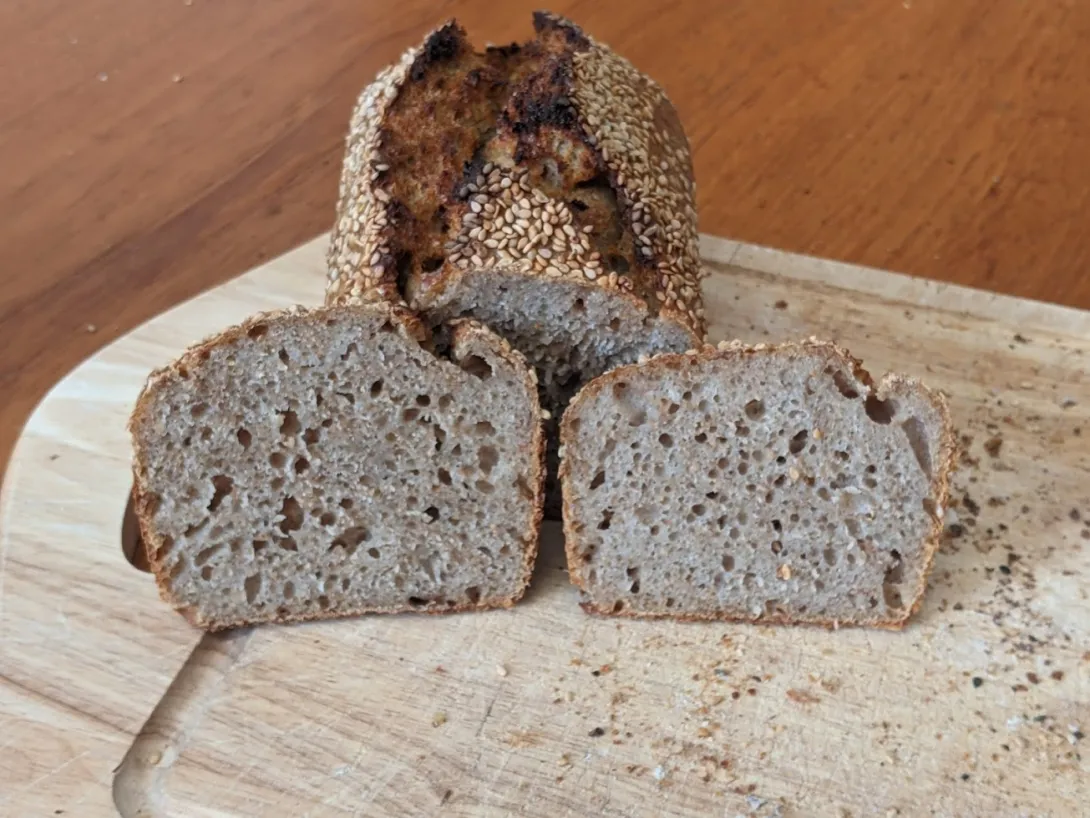
Incidentally there have been discussions here recently about using "weak" or unfed starter from the fridge, and I just baked some bread like that yesterday.
Ran out of bread, and my plan for a specific bake yesterday was not meant to be (starter was not quite there yet). Didn't even have much of my normal refrigerated rye starter that I would use in a bread without issues. But I had relatively recent discard from the last week or two, a mix of whole rye 100% hydration and white 50% hydration stiff starter. I took all discard I had and some of the relatively fresh starter, mixed with some bread and whole wheat flour, salt, and water. I was roughly weighing ingredients, but I didn't know the exact hydration of the discard, and there was quite a lot of it, so I had to adjust the hydration by adding extra flour after the dough turned out to be way more liquidy than I expected from my rough calculation.
Here is the approximate formula, take the numbers with a grain of salt: https://fgbc.dk/1ab1
At first it appeared that everything was going well, I did some stretch&folds and slap&folds, it seemed to develop some strength. Then I left it to ferment for a few hours with occasional stretch&folds. However in the end the dough was weak and sticky, as if overfermented - although there were barely any signs of fermentation visible. I think the discard brought too much acidity and the gluten never formed properly, or got degraded very quickly. So I just dumped the dough into two small tins (could have put in one, but I was worried it might decide to grow), sprinkled sesame seeds on top and left in the fridge overnight. Didn't notice much growth by morning, but when baked the bread had a nice oven spring, and generally looked good!
[url=https://ibb.co/4MtcSny] [/url]
[/url]
[url=https://ibb.co/R7zJzBx] [/url]
[/url]
It is on the sour side of my typical bread, the crumb is a little moist, but soft. On the picture it looks a little better than it is for most of the loaf, for some reason it's more open close to the end, and a little more closed and dense inside - but it's still actually good throughout. The crumb tears just a little when cutting, like into shreds... A bit like rye bread with not perfect crumb does. But it's a very minor issue, which doesn't really affect the eating experience.
Overall, it's a surprisingly good bread!
Just wanted to share this as an example of baking with unfed starter, it can cause challenges, but bread can also turn out well!
- Ilya Flyamer's Blog
- Log in or register to post comments
Ilya those look quite good. I guess you ran into acid related challenges which don’t really surprise me depending on how long that starter discard was in the fridge for. When I was checking pH more regularly than I do now, I’d find that my red fife starter after a week would have a pH in the 3.6 range and rye lower around 3.5 or so. So that unfed starter might be at the lowest level around 3.4 and with a really high TTA.
In the end it baked up two nice loaves which is quite impressive.
Benny
Thanks Benny - indeed, I think the acid load was too high from the beginning, and after a short fermentation the gluten started degrading. The rye discard had a layer of hooch on top (which I tried to remove), so it sure must have been very sour. Fermentation-wise I am sure the dough would benefit from more time, but gluten would be completely destroyed.
Thought this story wouldn't have a happy ending, but it did! Surprising that you got the oven spring that you did. So, maybe as Benny said the acidity/proteases broke the dough open, but the fermentation still had some way to go? A puzzle, but what a great outcome.
I agree the dough was likely a bit underfermented in the sense of gas production, but I think longer time, especially a longer warm bulk, would completely destroy the gluten. So probably I caught it in the middle ground with sufficient trapped CO2/grown microbial population, and still with a bit of strength.